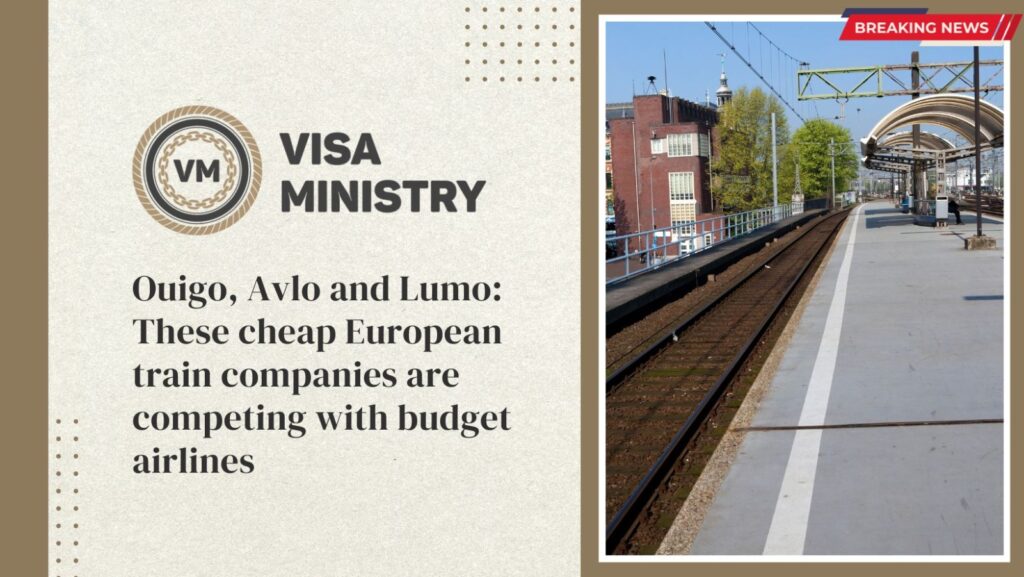Low-cost railroads are competing with low-cost flights, but without the carbon emissions.
Many environmentally concerned tourists experience flying guilt, yet they still find it difficult to say no to really inexpensive airfares.
According to a 2021 research by the UK consumer organisation Which?, trains on common routes generate six times fewer emissions than aeroplanes but are 49% more expensive.
The government provides billions of euros in subsidies to maintain this pricing advantage, which keeps aircraft in the air.
But things are changing. New lines are being opened by budget train operators all throughout Europe. It’s also timely because short-haul aircraft will no longer be allowed in France starting in 2022, which would increase the need for affordable trains.
They provide inexpensive, basic fares, much like low-cost airlines. They do not contribute to global warming, unlike low-cost aeroplanes.
To learn everything, continue reading.
Which European rail lines provide affordable travel?
By using a few straightforward strategies, it’s feasible to get affordable rail fares on practically every European route. Even on premium trains, you may get a great discount if you book in advance and outside of peak hours.
Additionally, governments are implementing a number of programmes to promote rail travel. Spain recently provided free tickets on a number of lines, while Germany just renewed its affordable regional transit ticket. In a programme that was announced earlier this week, the EU is giving 35,000 young people free rail passes.
However, there are also more and more train companies who specifically promote themselves as “budget” options.
Their branding frequently resembles that of budget airlines like Wizz Air—bright colours, strong fonts, and memorable names with fewer than three syllables.
It’s wise to check before you travel because, like these airlines, they may have luggage restrictions and surcharges for extras like charging stations.
France’s greatest affordable rail company is Ouigo.
The low-cost, high-speed Ouigo trains connect Paris with important towns including Lyon, Aix, Marseille, Cannes, Nice, Nimes, Montpellier, Bordeaux, Toulouse, Rennes, Angers, Nantes, and Strasbourg. Ouigo was founded as the SNCF’s budget branch.
How much do Ouigo rail tickets cost in France?
When purchased in advance, tickets cost as little as €10, however they might cost substantially more on the day of departure.
In March, the average cost of a ticket between Paris and Lyon is €65, according to the airline search engine Skyscanner. The cost of a flight from Paris to Marseille is €39. On both of these routes, Ouigo offers more affordable rates, beginning at €10.
Does Ouigo impose additional luggage fees?
Like a low-cost airline, Ouigo does charge an additional fee for extras, such as €2 for a seat with a power outlet. One piece of luggage, including handles and wheels, must not exceed 36 x 27 x 15 cm or 55 x 35 x 25 cm. There are no limitations on weight.
Cheap trains in Spain: Avlo, offering ‘Basic’ yet affordable alternatives
The low-cost division of Spanish rail company Renfe is called Avlo. They operate high-speed routes between Madrid, Zaragoza, and Barcelona at a speed of 300 km/h. The starting price for these services is €7, or €5 for those under the age of 14. The basic fee is the only class offered.
Tickets for the low-cost service between Madrid and Andalusia have recently been made available by Renfe, with pricing beginning at €7 and service beginning on June 1. The first two trains each day, leaving early in the morning and returning in the afternoon, will run between Seville and Madrid and Malaga and Madrid on Avlo’s first service to Andalusia.
These trains are far less expensive than flying. The average cost of a flight between the two largest cities in Spain is between €30 and €60.
Does Avlo impose additional baggage fees?
Passengers on the Avlo are permitted one piece of hand luggage with maximum dimensions of 36x27x25 cm and no weight restriction, as well as one cabin bag with maximum dimensions of 55x35x25 cm. Additional baggage may be purchased for €10 at the register or €15 at the train station.
Cheap trains in Spain Iryo for frequent transportation between major cities
Privately owned low-cost Spanish carrier Iryo faces up against Renfe. At the end of March of this year, the company launched its services between Madrid and Andalusia. Routes from Madrid and Barcelona are also available.
Similar to Avlo, it takes around two hours and thirty minutes to travel between Seville and Madrid on an Iryo high-speed train. However, with four services per day from early in the morning to late at night, their trains provide more options.
Starting at about €18, there are four different ticket classes from which to pick, depending on your budget. There are no restrictions on adjustments to any of the prices.
Does Iryo impose additional baggage fees?
As long as they fit in the area given and don’t obstruct security procedures on board the train, Iryo travellers are permitted to bring up to three pieces of luggage at no additional cost. Two of these items may have a maximum combined size of 85x55x35cm, and one of these items may be hand baggage with a maximum combined size of 36x27x15cm.
Italy’s low-cost trains: Italo guidelines for fast, affordable solutions
In Italy, a private enterprise that competes with the government-run rail operator runs the Italo trains. It runs extremely affordable train choices.
Starting at €10.90, one may travel from Florence to Rome and from Milan to Venice. For these options, the typical flight in March costs about €45.
You will need to pay €19.90 for tickets from Milan to Rome and from Rome to Venice. In contrast, a flight in March would often cost between $20 and $30.
Does Italo impose additional baggage fees?
There is no restriction on the quantity or size of the bags you can bring on board; they are included in the price of your ticket.
Train service between London and Edinburgh: Lumo can assist with flight remorse
Lumo exhorts tourists to choose a rail trip in order to “cure their flight shame.” Their website states, “A great trip shouldn’t cost the earth.”
The firm runs an all electrified east coast route from London to Edinburgh. The lowest fare is £26.90 (€32). In contrast, the cost of a typical flight ranges from €35 to €70.
“Lumo is a 100% electric train operator that travels along the East Coast Mainline between Edinburgh and London. According to the most recent data, just 0.006 kg of CO2 equivalent are emitted per passenger each kilometre, which is 40 times less than the 0.24587 kg of CO2 equivalent released per passenger per km during air travel, a spokeswoman said.
The time and money needed to travel to and from airports are also eliminated by the city-to-city concept.
For the first time in decades, more people are taking the train than the plane between Edinburgh and London, according to Lumo. “Our pricing model has now encouraged over one million customers to take the train between the capital cities,” he added.
Does Lumo impose additional baggage fees?
One small bag and one suitcase, at most, are allowed per passenger. The large bag cannot measure more than 63 x 41 x 27cm, while the little bag must fit on the overhead rack.
Why take the train?
One of the largest things a person can do to lessen their carbon footprint is to stop flying, along with not driving a car with a combustion engine, using less energy at home, and adopting a plant-based diet.
A roundtrip journey from Athens to London will emit 622 kg of carbon dioxide, or about six times the yearly emissions output of a person in Burundi, according to the reliable carbon calculator journey Emission Map.
SOURCE – euronews

